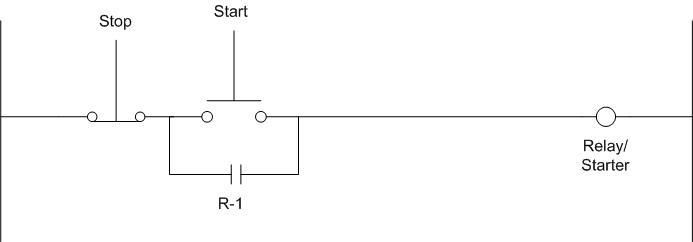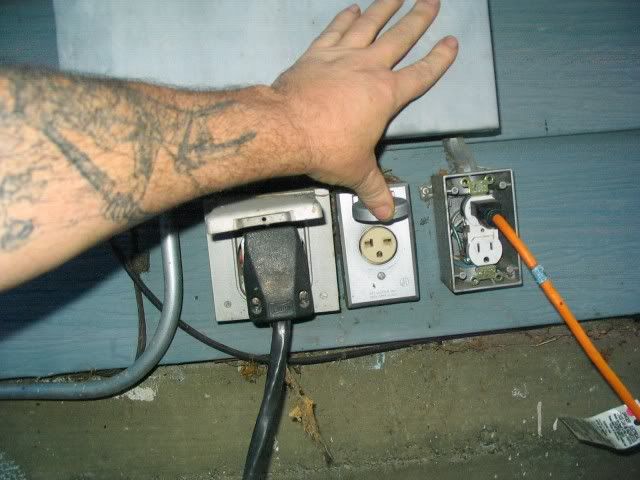In industrial controls, almost all machines use what is called a three wire control. One big reason for this is to keep a machine from restarting when there is a loss of power. Below is a diagram of a simple three wire start/stop. There are a few rules for this set up as follows. All stop switches are normally closed, and all start switches are normally open. There are a few instances where this rule doesn't apply, such as on a shear machine where both hands are needed to actuate the controls (a safety feature).

The way this works is the stop button is normally closed. The start button is pushed which closes the circuit. The relay pulls in which closes a set of auxiliary contacts that is wired in parallel with the start button. When the start button is released, the aux. contacts electrically hold the circuit closed until the stop button is pushed, which then opens the circuit and releases the relay opening the aux. contacts. In the event of a power failure, the circuit would not restart when power is restored without pushing the start button again. I hope this explanation of how this set-up works isn't too hard to understand.
It may be worth a look around your shop at the equipment you have and think about what would happen if you were in the middle of a cut and the power went of, then unexpectedly came back on. Would it harm the equipment? Could it be dangerous to you the operator? Could it ruin the part? If the answer to any of these questions is "yes", then you may consider putting in a fail safe control to keep a potential disaster from happening.
Most home shop equipment is not built to the standards that industrial equipment is for cost and compliance with regulations. For example, I have a horizontal band saw that has just a toggle switch on it to control the motor. In the event of a power failure and restoration, the saw would restart when the power comes back on which could damage the saw, blade, or me if I had my hand in the wrong place. With a three wire control, the fail safe would be built in and a power failure would just be an inconvenience.
Setting up a control such as above shouldn't be terribly expensive, and could even pay for itself in the event there is a short blackout. The switches and enclosures (if needed) are inexpensive, and cost of one carbide insert would most likely cover the cost of the modification (materials wise).
One last thing, if the lights do go out when you are in the middle of an operation, be sure to turn the equipment "off" before leaving the machine. If you can unplug the equipment or otherwise disconnect the power source, then that would be a best practice.
Work safe!

The way this works is the stop button is normally closed. The start button is pushed which closes the circuit. The relay pulls in which closes a set of auxiliary contacts that is wired in parallel with the start button. When the start button is released, the aux. contacts electrically hold the circuit closed until the stop button is pushed, which then opens the circuit and releases the relay opening the aux. contacts. In the event of a power failure, the circuit would not restart when power is restored without pushing the start button again. I hope this explanation of how this set-up works isn't too hard to understand.
It may be worth a look around your shop at the equipment you have and think about what would happen if you were in the middle of a cut and the power went of, then unexpectedly came back on. Would it harm the equipment? Could it be dangerous to you the operator? Could it ruin the part? If the answer to any of these questions is "yes", then you may consider putting in a fail safe control to keep a potential disaster from happening.
Most home shop equipment is not built to the standards that industrial equipment is for cost and compliance with regulations. For example, I have a horizontal band saw that has just a toggle switch on it to control the motor. In the event of a power failure and restoration, the saw would restart when the power comes back on which could damage the saw, blade, or me if I had my hand in the wrong place. With a three wire control, the fail safe would be built in and a power failure would just be an inconvenience.
Setting up a control such as above shouldn't be terribly expensive, and could even pay for itself in the event there is a short blackout. The switches and enclosures (if needed) are inexpensive, and cost of one carbide insert would most likely cover the cost of the modification (materials wise).
One last thing, if the lights do go out when you are in the middle of an operation, be sure to turn the equipment "off" before leaving the machine. If you can unplug the equipment or otherwise disconnect the power source, then that would be a best practice.
Work safe!





